Iron pillar of Delhi
The Iron Pillar located in Delhi, India, is a 7 m (23 ft) column in the Qutb complex, notable for the rust-resistant composition of the metals used in its construction.
The pillar has attracted the attention of archaeologists and materials scientists and has been called "a testament to the skill of ancient Indian blacksmiths" because of its high resistance to corrosion.[1] The corrosion resistance results from an even layer of crystalline iron hydrogen phosphate hydrate forming on the high phosphorus content iron, which serves to protect it from the effects of the local Delhi climate.[2]
The pillar weighs over 6,000 kg (13,000 lb), and is thought to have originally been erected in what is now Udayagiri by one of the Gupta monarchs in approximately 402 AD, though the precise date and location are a matter of dispute.[3] It was transported to its current location in 1233 AD.[4]
Description
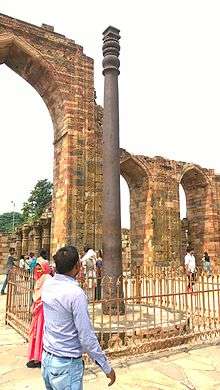


The height of the pillar, from the top of its capital to the bottom of its base, is 7.21 m (23 ft 8 in), 1.12 m (3 ft 8 in) of which is below ground. Its bell pattern capital is 1.07 m (3 ft 6 in) in height, and its bulb-shaped base is 0.71 m (2 ft 4 in) high. The base rests on a grid of iron bars soldered with lead into the upper layer of the dressed stone pavement. The pillar's lower diameter is 420 mm (17 in), and its upper diameter 306 mm (12 in). It is estimated to weigh more than six tonnes (13,228 lb).[5]
A fence was erected around the pillar in 1997 in response to damage caused by visitors. There is a popular tradition that it was considered good luck if one could stand with one's back to the pillar and make one's hands meet behind it. The practice led to significant wear and visible discolouration on the lower portion of the pillar.
Original location
The first location of the pillar has been debated.[6]
While the pillar was certainly used as a trophy in building the Quwwat-ul-Islam mosque and the Qutb complex, its original location, whether on the site itself or from elsewhere, has been discussed frequently. A summary of views on this subject and related matters was collected in volume edited by M. C. Joshi and published in 1989.[7] More recently, opinions have been summarised again by Upinder Singh in her book Delhi: Ancient History.[8]
R. Balasubramaniam explored the metallurgy of the pillar and the iconography based on analysis of archer-type Gupta gold coins.[9] In his view, the pillar, with a wheel or discus at the top, was originally located at the Udayagiri Caves, situated near Vidisha in Madhya Pradesh.[10] This conclusion was partly based on the fact that the inscription mentions Viṣṇupadagiri (meaning "hill with footprint of Viṣṇu"). This conclusion was endorsed and elaborated by Michael Willis in his Archaeology of Hindu Ritual, published in 2009.[11] The key point in favour of placing the iron pillar at Udayagiri is that this site was closely associated with Chandragupta and the worship of Viṣṇu in the Gupta period. In addition, there are well-established traditions of mining and working iron in central India, documented particularly by the iron pillar at Dhar and local place names like Lohapura and Lohangī Pīr (see Vidisha). The king of Delhi, Iltutmish, is known to have attacked and sacked Vidisha in the thirteenth century and this would have given him an opportunity to remove the pillar as a trophy to Delhi, just as the Tughluq rulers brought Asokan pillars to Delhi in the 1300s.
Inscriptions
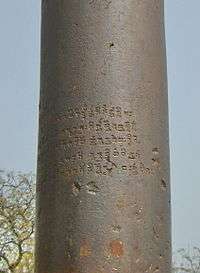
The pillar carries a number of inscriptions and graffiti of different dates which have not been studied systematically despite the pillar's prominent location and easy access. The oldest inscription on the pillar is in Sanskrit, written in Gupta-period Brahmi script.[12] This states that the pillar was erected as a standard in honour of Viṣṇu. It also praises the valour and qualities of a king referred to simply as Candra, now generally identified with the Gupta King Chandragupta II.[13] Some authors attempted to identify Candra with Chandragupta Maurya and yet others have claimed the pillar dates as early as 912 BC.[14] These views are no longer accepted.
The dating of the inscription is supported by the nature of the script and the Sanskrit poetics, both of which reflect the conventions of Gupta times. Thanks to the tablets installed on the building in 1903 by Pandit Banke Rai, the reading provided by him enjoys wide currency. His interpretation has, however, been overtaken by more recent scholarship. The 1903 tablets read as follows:
He, on whose arm fame was inscribed by the sword, when, in battle in the Vanga countries (Bengal), he kneaded (and turned) back with (his) breast the enemies who, uniting together, came against (him);-he, by whom, having crossed in warfare the seven mouths of the (river) Sindhu, the Vahlikas were conquered;-he, by the breezes of whose prowess the southern ocean is even still perfumed;-(Line 3.)-He, the remnant of the great zeal of whose energy, which utterly destroyed (his) enemies, like (the remnant of the great glowing heat) of a burned-out fire in a great forest, even now leaves not the earth; though he, the king, as if wearied, has quit this earth, and has gone to the other world, moving in (bodily) from to the land (of paradise) won by (the merit of his) actions, (but) remaining on (this) earth by (the memory of his) fame;- (L. 5.)-By him, the king,-who attained sole supreme sovereignty in the world, acquired by his own arm and (enjoyed) for a very long time; (and) who, having the name of Chandra, carried a beauty of countenance like (the beauty of) the full-moon,-having in faith fixed his mind upon (the god) Vishnu, this lofty standard of the divine Vishnu was set up on the hill (called) Vishnupada.
The inscription has been revisited by Michael Willis in his book Archaeology of Hindu Ritual, his special concern being the nature of the king's spiritual identity after death. His reading and translation is as follows:[15]
[khi]nnasyeva visṛjya gāṃ narapater ggām āśritasyetarāṃ mūrtyā karrmajitāvaniṃ gatavataḥ kīrtyā sthitasya kṣitau [*|]
śāntasyeva mahāvane hutabhujo yasya pratāpo mahān nādyāpy utsṛjati praṇāśitaripor yyatnasya śeṣaḥ kṣitim [||*]
The residue of the king's effort – a burning splendour which utterly destroyed his enemies – leaves not the earth even now, just like (the residual heat of) a burned-out conflagration in a great forest. He, as if wearied, has abandoned this world, and resorted in actual form to the other world – a place won by the merit of his deeds – (and although) he has departed, he remains on earth through (the memory of his) fame (kīrti).
He concludes: "Candragupta may have passed away but the legacy of his achievement is so great that he seems to remain on earth by virtue of his fame. Emphasis is placed on Candragupta's conquest of enemies and the merit of his deeds, ideas which are also found in coin legends: kṣitim avajitya sucaritair divaṃ jayati vikramādityaḥ, i.e. 'Having conquered the earth with good conduct, Vikramāditya conquered heaven'.[16] The king's conquest of heaven combined with the description of him resorting to the other world in bodily form (gām āśritasyetarāṃ mūrtyā), confirms our understanding of the worthy dead as autonomous theomorphic entities."
One of the later inscriptions, dated to 1052 AD, mentions Tomara king Anangpal II.[17] This has suggested by some, without any substantial basis, that the pillar was installed in its current location by Vigraha Rāja, the ruling Tomar king.[18]
Scientific analysis
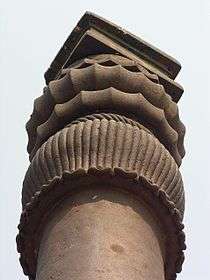
The pillar was manufactured by the forge welding of pieces of wrought iron. In a report published in the journal Current Science, R. Balasubramaniam of the IIT Kanpur explains how the pillar's resistance to corrosion is due to a passive protective film at the iron-rust interface. The presence of second-phase particles (slag and unreduced iron oxides) in the microstructure of the iron, that of high amounts of phosphorus in the metal, and the alternate wetting and drying existing under atmospheric conditions are the three main factors in the three-stage formation of that protective passive film.[19]
Lepidocrocite and goethite are the first amorphous iron oxyhydroxides that appear upon oxidation of iron. High corrosion rates are initially observed. Then, an essential chemical reaction intervenes: slag and unreduced iron oxides (second phase particles) in the iron microstructure alter the polarisation characteristics and enrich the metal–scale interface with phosphorus, thus indirectly promoting passivation of the iron[20] (cessation of rusting activity). The second-phase particles act as a cathode, and the metal itself serves as anode, for a mini-galvanic corrosion reaction during environment exposure. Part of the initial iron oxyhydroxides is also transformed into magnetite, which somewhat slows down the process of corrosion. The ongoing reduction of lepidocrocite and the diffusion of oxygen and complementary corrosion through the cracks and pores in the rust still contribute to the corrosion mechanism from atmospheric conditions.
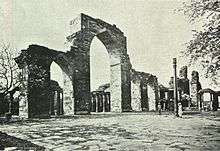
The next main agent to intervene in protection from oxidation is phosphorus, enhanced at the metal–scale interface by the same chemical interaction previously described between the slags and the metal. The ancient Indian smiths did not add lime to their furnaces. The use of limestone as in modern blast furnaces yields pig iron that is later converted into steel; in the process, most phosphorus is carried away by the slag.[21] The absence of lime in the slag and the use of specific quantities of wood with high phosphorus content (for example, Cassia auriculata) during the smelting induces a higher phosphorus content (> 0.1%, average 0.25%) than in modern iron produced in blast furnaces (usually less than 0.05%). One analysis gives 0.10% in the slags for 0.18% in the iron itself. This high phosphorus content and particular repartition are essential catalysts in the formation of a passive protective film of misawite (d-FeOOH), an amorphous iron oxyhydroxide that forms a barrier by adhering next to the interface between metal and rust. Misawite, the initial corrosion-resistance agent, was thus named because of the pioneering studies of Misawa and co-workers on the effects of phosphorus and copper and those of alternating atmospheric conditions in rust formation.[22]
The most critical corrosion-resistance agent is iron hydrogen phosphate hydrate (FePO4-H3PO4-4H2O) under its crystalline form and building up as a thin layer next to the interface between metal and rust. Rust initially contains iron oxide/oxyhydroxides in their amorphous forms. Due to the initial corrosion of metal, there is more phosphorus at the metal–scale interface than in the bulk of the metal. Alternate environmental wetting and drying cycles provide the moisture for phosphoric-acid formation. Over time, the amorphous phosphate is precipitated into its crystalline form (the latter being therefore an indicator of old age, as this precipitation is a rather slow happening). The crystalline phosphate eventually forms a continuous layer next to the metal, which results in an excellent corrosion resistance layer.[2] In 1,600 years, the film has grown just one-twentieth of a millimetre thick.[20]
In 1969, in his first book, Chariots of the Gods?, Erich von Däniken cited the absence of corrosion on the Delhi pillar and the unknown nature of its creation as evidence of extraterrestrial visitation.[23] When informed by an interviewer, in 1974, that the column was not in fact rust-free, and that its method of construction was well understood, von Däniken responded that he no longer considered the pillar or its creation to be a mystery.[24][25]
Balasubramaniam states that the pillar is "a living testimony to the skill of metallurgists of ancient India". An interview with Balasubramaniam and his work can be seen in the 2005 article by Veazy.[4] Further research published in 2009 showed that corrosion has developed evenly over the surface of the pillar.[26]
It was claimed in the 1920s that iron manufactured in Mirjati near Jamshedpur is similar to the iron of the Delhi pillar.[27] Further work on Adivasi (tribal) iron by the National Metallurgical Laboratory in the 1960s did not verify this claim.[28]
Evidence of cannonball strike
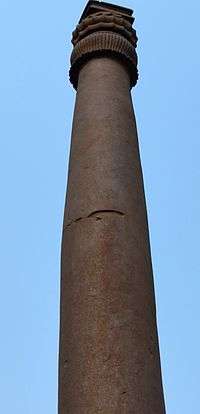
A significant indentation on the middle section of the pillar, approximately 400 cm (156 in) from the current courtyard ground level, has been shown to be the result of a cannonball fired at close range.[29] The impact caused horizontal fissuring of the column in the area diametrically opposite to the indentation site, but the column itself remained intact. While no contemporaneous records, inscriptions, or documents describing the event are known to exist, historians generally agree that Nadir Shah is likely to have ordered the pillar's destruction during his invasion of Delhi in 1739 AD, as he would have considered a Hindu temple monument undesirable within an Islamic mosque complex.[30] Alternatively, he may have sought to dislodge the decorative top portion of the pillar in search of hidden precious stones or other items of value.[31]
No additional damage attributable to cannon fire has been found on the pillar, suggesting that no further shots were taken. Historians have speculated that ricocheting fragments of the cannonball may have damaged the nearby Quwwat-ul-Islam mosque — which is known to have suffered damage to its southwestern portion during the same period — and the assault on the pillar might have been abandoned as a result.[32]
See also
- History of metallurgy in the Indian subcontinent
- Wootz steel
- Parkerizing
- Serpent Column
- Qutb complex
References
- ↑ Waseda, Yoshio; Shigeru Suzuki (2006). Characterization of corrosion products on steel surfaces. Pg.vii. ISBN 978-3-540-35177-1. Retrieved 2009-05-27.
- 1 2 On the Corrosion Resistance of the Delhi Iron Pillar, R. Balasubramaniam, Corrosion Science, Volume 42 (2000) pp. 2103–2129. "Corrosion Science" is a publication specialized in corrosion science and engineering.
- ↑ Balasubramaniam, Ramamurthy (2005). Story of the Delhi Iron Pillar. Pg.1. Foundation Books. ISBN 81-7596-278-X. Retrieved 2015-07-13.
- 1 2 1600 Years Young, Materials Performance, July, 2005.
- ↑ Joshi, M.C. (2007). "The Mehrauli Iron Pillar". Delhi: Ancient History. Berghahn Books. ISBN 978-81-87358-29-9.
- ↑ Javid, Ali; Javeed, Tabassum (2007). World Heritage Monuments and Related Edifices in India Vol 1. Pg.107. Algora Publishing. ISBN 978-0-87586-482-2. Retrieved 29 October 2012.
- ↑ M.C. Joshi, S. K. Gupta and Shankar Goyal, eds., King Chandra and the Mehrauli Pillar (Meerut, 1989).
- ↑ Upinder Singh, Delhi: Ancient History (Delhi, 2007).
- ↑ Identity of Chandra and Vishnupadagiri of the Delhi Iron Pillar Inscription: Numismatic, Archaeological and Literary Evidence, R Balasubramaniam, Bulletin of Metals Museum, 32 (2000) 42–64.
- ↑ On the Astronomical Significance of the Delhi Iron Pillar, R Balasubramaniam and Meera I Dass, Current Science, volume 86 (2004) pp. 1134–1142.
- ↑ Michael D. Willis, The Archaeology of Hindu Ritual (Cambridge, 2009). Partly available online, see http://www.cambridge.org/gb/knowledge/isbn/item2427416/?site_locale=en_GB
- ↑ Agrawal, Ashvini (1989). Rise and fall of the imperial Guptas. Pg.177. Motilal Banarsidass. ISBN 978-81-208-0592-7. Retrieved 29 October 2012.
- ↑ Balasubramaniam, R. 2002
- ↑ Arnold Silcock; Maxwell Ayrton (2003). Wrought iron and its decorative use: with 241 illustrations (reprint ed.). Mineola, N.Y: Dover Publications. p. 4. ISBN 0-486-42326-3.
- ↑ Michael Willis, The Archaeology of Hindu Ritual (Cambridge University Press, 2009): chapter 3, ISBN 0521518741
- ↑ James Allan, Catalogue of the Coins of the Gupta Dynasties, pp. 34–5.
- ↑ Hickey, William (1874). The Tanjore Mahratta Principality in Southern India. Pg.xix. C. Foster. Retrieved 29 October 2012.
- ↑ Chaurasia, Radhey Shyam (2002). History of Ancient India Earliest Times To 1200 A.D. Pg.209. Atlantic Publishers. ISBN 978-81-269-0027-5. Retrieved 2009-05-26.
- ↑ On the Corrosion Resistance of the Delhi Iron Pillar, R. Balasubramaniam, Corrosion Science, Volume 42 (2000) pp. 2103–2129.
- 1 2 On the growth kinetics of the protective passive film of the Delhi Iron Pillar, R. Balasubramaniam, Department of Materials and Metallurgical Engineering, Indian Institute of Technology, Kanpur 208 016, India. Current Science, vol. 82, no. 11, 10 June 2002.
- ↑ On the Origin of High Phosphorus Content in Ancient Indian Iron, Vikas Kumar and R. Balasubramaniam, International Journal of Metals, Materials and Processes, vol. 14, pp. 1–14. 2002
- ↑ The mechanism of atmospheric rusting and the effect of Cu and P on the rust formation of low alloy steels, T. Misawa, T. Kyuno, W. Suetaka, S. Shimodaira, Corrosion Science 11 (1971) 35–48.
- ↑ Däniken, Erich von: Chariots of the Gods?, p. 94.
- ↑ Playboy magazine, page 64, Volume 21 Number 8, 1974
- ↑ Story 1980, pp. 88–89
- ↑ Kamachi Mudali, U.; Baldev Raj (February 2009). "Insitu corrosion investigations on Delhi iron pillar". Transactions of the Indian Institute of Metals. 62 (1): 25–33. doi:10.1007/s12666-009-0004-2.
- ↑ Andrew McWilliam 1920, cited in Chakrabarti 1992
- ↑ Some Observations on Corrosion-Resistance of Ancient Delhi Iron Pillar and Present-time Adivasi Iron Made by Primitive Methods, A.K. Lahiri, T. Banerjee and B.R. Nijhawan. NML Tech. J., 5 (1963) 46-5. Cited in On the corrosion resistance of the Delhi iron pillar, R. Balasubramaniam.
- ↑ Prasad KK, Ray HS. The Making of (and attempts at breaking) the Iron Pillar of Delhi. Steel World, No. 1 (2001) pp. 51-56. Retrieved February 3, 2015.
- ↑ Hearne GR. The Seven Cities of Delhi. Nabu Press (2010), p. 62. ISBN 114954399X. Retrieved February 3, 2015.
- ↑ Balasubramaniam R. Decorative Bell Capital of the Delhi Iron Pillar. Journal of Operations Management, 50(3) (1998), pp. 40-47. Retrieved February 3, 2015.
- ↑ Balasubramaniam R, Prabhakar VN, Shankar M. On Technical Analysis of Cannon Shot Crater on Delhi Iron Pillar. Indian Journal of History of Science, 44.1 (2009), pp. 29-46. Retrieved February 3, 2015.
Further reading
- King Chandra and the Mehrauli Pillar, M.C. Joshi, S.K. Gupta and Shankar Goyal, Eds., Kusumanjali Publications, Meerut, 1989.
- The Rustless Wonder – A Study of the Iron Pillar at Delhi, T.R. Anantharaman, Vigyan Prasar New Delhi, 1996.
- Delhi Iron Pillar: New Insights. R. Balasubramaniam, Aryan Books International, Delhi, and Indian Institute of Advanced Study, Shimla, 2002, Hardbound, ISBN 81-7305-223-9.
- The Delhi Iron Pillar: Its Art, Metallurgy and Inscriptions, M.C. Joshi, S.K. Gupta and Shankar Goyal, Eds., Kusumanjali Publications, Meerut, 1996.
- The World Heritage Complex of the Qutub, R. Balasubramaniam, Aryan Books International, New Delhi, 2005, Hardbound, ISBN 81-7305-293-X.
- Story of the Delhi Iron Pillar, R. Balasubramaniam, Foundation Books, New Delhi, 2005, Paperback, ISBN 81-7596-278-X.
- "Delhi Iron Pillar" (in two parts), R. Balasubramaniam, IIM Metal News Volume 7, No. 2, April 2004, pp. 11–17 and IIM Metal News Volume 7, No. 3, June 2004, pp. 5–13.
- New Insights on the 1600-Year Old Corrosion Resistant Delhi Iron Pillar, R. Balasubramaniam, Indian Journal of History of Science 36 (2001) 1–49.
- The Early use of Iron in India, Dilip K. Chakrabarti, Oxford University Press, New Delhi, 1992, ISBN 0195629922.
External links
| Wikimedia Commons has media related to iron pillar. |
- Detailed list of Publications on Delhi Iron Pillar by Balasubramaniam, IIT Kanpur
- Corrosion resistance of Delhi iron pillar
- Nondestructive evaluation of the Delhi iron pillar Current Science, Indian Academy of Sciences, Vol. 88, No. 12, 25 June 2005 (PDF)
- The Delhi Iron Pillar
- IIT team solves the pillar mystery, 21 Mar 2005, Times of India (About Nondestructive evaluation of the Delhi iron pillar)
- Indians develop new iron using ancient technology
- (General article on Delhi Iron Pillar in "One India One People", May 2006, By Prof R Balasubramanium, IIT Kanpur and S M Khened, Nehru Science Centre, Mumbai)
Coordinates: 28°31′28.76″N 77°11′6.25″E / 28.5246556°N 77.1850694°E
